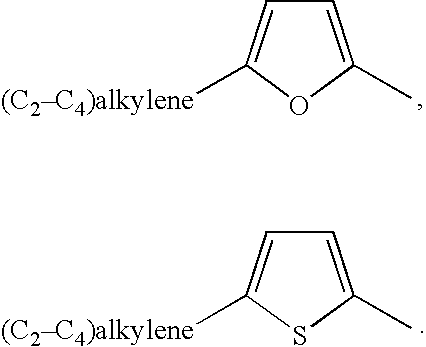Methods of treatment using an EP2 selective receptor agonist
a selective receptor and agonist technology, applied in the field of pulmonary hypertension, can solve the problems of gastrointestinal bleeding, decreased physical activity, dehydration, etc., and achieve the effects of reducing secondary fractures, facilitating joint fusion, and facilitating tendon and ligament repair
- Summary
- Abstract
- Description
- Claims
- Application Information
AI Technical Summary
Benefits of technology
Problems solved by technology
Method used
Image
Examples
example a
[0359] To obtain dosage form at strengths of 5 and 50 mgA / ml, the following combinations A) and B) of lyophile and polymer syringe, respectively, were used: [0360] A) 5 mgA / ml (upon reconstitution) of (3-(((4-tert-butyl-benzyl)-(pyridine-3-sulfonyl)-amino)-methyl)-phenoxy)-acetic acid, sodium salt formulation: [0361] Drug Syringe A contained 4 mgA of the sodium salt lyophile in 1.25 ml male syringe without graduations; and [0362] Vehicle Syringe B contained 0.8 ml 50% RG502H / 50% NMP solution in 1.25 ml female syringe without graduations. [0363] B) 50 mgA / ml (upon reconstitution) of (3-(((4-tert-butyl-benzyl)-(pyridine-3-sulfonyl)-amino)-methyl)-phenoxy)-acetic acid, sodium salt formulation: [0364] Drug Syringe A contained 40 mgA of the sodium salt lyophile in 1.25 ml male (fat) B-D syringe without graduations; and [0365] Vehicle Syringe B contained 0.8 ml 50% RG502H / 50% NMP solution in 1.25 ml female (thin) syringe without graduations.
[0366] MgA refers to free acid equivalent of th...
example 1
7-((4-Butyl-benzyl)-(pyridine-3-sulfonyl)-amino)-heptanoic acid
Step A: Reductive Amination
[0423] 7-(4-Butyl-benzylamino)-heptanoic acid methyl ester. A solution of 7-amino-heptanoic acid methyl ester hydrochloride, prepared of Preparation 1, (1.12 g, 5.9 mmol), 4-butyl-benzaldehyde (0.915 g, 5.65 mmol), and triethylamine (0.83 mL, 5.98 mmol) in 20 mL MeOH was stirred at room temperature for 3 hours. After cooling to 0° C., NaBH4 (0.342 g, 9.04 mmol) was added and the reaction was stirred for 15 minutes at room temperature. The mixture was quenched with 1:1 NaHCO3:H2O and the MeOH was removed in vacuo. The resulting residue was diluted with CH2Cl2 and the organic solution was washed with water and brine, dried over MgSO4, filtered, and concentrated in vacuo to afford the title compound of Step A (1.4 g). 1H NMR (400 MHz, CDCl3) δ 7.08-7.38 (m, 4H), 3.62 (s, 2H), 3.29 (s, 3H), 2.52-2.66 (m, 4H), 2.25 (t, 2H), 1.53-1.63 (m, 6H), 1.25-1.40 (m, 6H), 0.85 (t, 3H); MS 306 (M+1).
Step B: ...
example 1a
7-(Benzenesulfonyl-(4-butyl-benzyl)-amino)-heptanoic acid
[0427]1H NMR (400 MHz, CDCl3) δ 7.83 (d, 2H), 7.51-7.59 (m, 3H), 7.11 (m, 4H), 4.28 (s, 2H), 3.07 (t, 2H), 2.57 (t, 2H), 2.24 (t, 2H), 1.51-1.59 (m, 2H), 1.44-1.49 (m, 2H), 1.27-1.35 (m, 4H), 1.08-1.15 (m, 4H), 0.91 (t, 3H); MS 430 (M−1).
PUM
| Property | Measurement | Unit |
|---|---|---|
| temperature | aaaaa | aaaaa |
| temperature | aaaaa | aaaaa |
| temperature | aaaaa | aaaaa |
Abstract
Description
Claims
Application Information
 Login to View More
Login to View More - R&D
- Intellectual Property
- Life Sciences
- Materials
- Tech Scout
- Unparalleled Data Quality
- Higher Quality Content
- 60% Fewer Hallucinations
Browse by: Latest US Patents, China's latest patents, Technical Efficacy Thesaurus, Application Domain, Technology Topic, Popular Technical Reports.
© 2025 PatSnap. All rights reserved.Legal|Privacy policy|Modern Slavery Act Transparency Statement|Sitemap|About US| Contact US: help@patsnap.com



